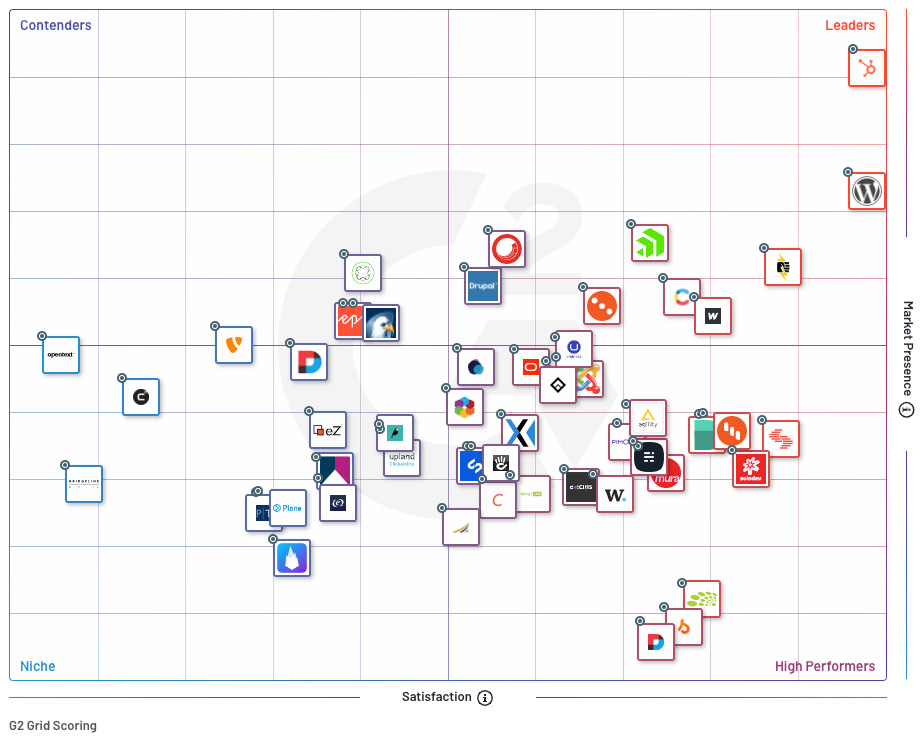If you're reading this article, you might be evaluating content management systems for your company website. You might be planning a website redesign. Or maybe you’re just frustrated with the lack of editing capabilities with your current content management system. You might also be evaluating the HubSpot CMS Hub and its capabilities.
We want to share our experience working with the HubSpot CMS Hub for the last several years. Our agency builds websites on both Wordpress and the HubSpot CMS Hub for clients, but chose to put our website on HubSpot CMS Hub for several reasons.
We’ll share those in this article, along with observations from several companies who have seen their businesses grow on the HubSpot CMS Hub platform.
In short, we’ve found that using HubSpot’s content management system to run your website can actually give your company a competitive advantage. How so? Here’s what we’ve found from working with the system.
Independent Third Party Ranks HubSpot CMS Hub as the Best Content Management System
G2Crowd ranks HubSpot CMS Hub as the best content management system. In its latest rankings, HubSpot CMS was named a “leader” for market presence and satisfaction. This holds true for small businesses, mid-market and enterprise companies. Businesses of all sizes are choosing HubSpot.
As part of a website redesign project, we advise clients to use either Wordpress or HubSpot CMS Hub based on their business goals, team culture and required website features.
Wordpress is HubSpot CMS Hub’s Main Competitor
Especially for small businesses and mid-market companies, Wordpress is an alternative to HubSpot CMS Hub. These two CMS platforms are similar in some ways, while having some fundamental differences as well.
Similarities Between HubSpot CMS Hub and Wordpress
- Both content management systems feature a drag and drop visual editor. This is important because marketers can maintain much of the website without code knowledge.
- Both systems can run a blog.
Differences Between HubSpot CMS Hub and Wordpress
- HubSpot CMS Hub is a proprietary system you license from HubSpot, while Wordpress is an open source content management system.
- Wordpress is free to install and use, but requires paid web hosting. You’ll also need to buy an SSL certificate for security and install it on your server, requiring a developer in most cases. HubSpot CMS Hub customers pay for a monthly subscription to use the content management system, and get the hosting, SSL certificate and regular software upgrades for one monthly fee.
- Wordpress has a robust community of plugin developers and plugins you can install on your Wordpress website. Many of these plugins are free. Some plugins, however, can conflict with others, causing issues only a developer can fix. HubSpot CMS Hub has a growing marketplace of free and paid add-ons for the product, but a developer can do almost anything he/she desires to build.
- HubSpot CMS Hub is built for marketers, while Wordpress is built for developers.
HubSpot CMS Hub is More Intuitive For Marketers
Many CMS platforms tout their ease of use and flexibility, but we've found that HubSpot CMS Hub’s ease of use actually surprises people. An analysis of our support requests indicates that Wordpress websites require more developer assistance than HubSpot websites.
A website you can update and maintain just makes good business sense. It’s the 2020’s, and you shouldn’t need a developer to make simple updates. Clearly, the trend in web development today is enabling marketing to control digital content, and reducing reliance on developers to make website changes.
The “what you see is what you get” editor lets you edit web pages precisely how you see them on the web. No more filling in forms or text fields and wondering how things will look when you publish them. Many content management systems are clunky and make it difficult or impossible for marketers to quickly get their work done.
Updating web pages on HubSpot CMS Hub will make your marketing team more efficient. This is going to end up saving you time. And if you need to send a draft version of a web page to someone in the company for approval, you can do this without them needing to log in.
Marketers will also like the ability to create specialized landing pages and forms without developer assistance. Prospects that fill out forms on your website will be automatically added to Contacts in your HubSpot portal, so there’s no need to cut and paste inquiries from email to CRM.
Marketers will also appreciate the ability to create call to action buttons and even A/B test color, wording and style to see which yields the best results.
When your website is easy to update, you’ll find yourself updating it more often, which benefits your customers and your business’ search engine optimization.
Two-Way Connectivity to Sales Tools

Here’s the thing about most corporate websites today. They are brochures. They aren’t connected to tools that help your sales team sell more. They email you when a customer fills out a contact form, and if that email hits your junk folder, you’ll miss a sales opportunity.
If your company is more digitally advanced, your website is connected to Salesforce or another CRM. This means that leads from your website go directly into the CRM. The problem here is that the CRM can’t update the website.
Because HubSpot CMS is part of HubSpot’s Growth Suite, web leads can flow into your CRM, and as your sales team work those leads and update information about the prospect, that information flows back into HubSpot where it can be used to personalize your website.
What’s the practical application for this? Let's say someone fills out a form on your website and downloads product information. When they revisit, your website knows they already downloaded the information. Your website knows to put something else, like a quote request form, in place of the e-book, helping to advance the sale.
Create The Blogs And Content You Want - How You Want It
Today’s leading companies are digital content publishers. As companies become publishers of thought leadership to meet the demands of today’s buyer, one blog may not be adequate.
Let’s say you have multiple product lines. Or your law firm has different practice areas. Or your business serves different industries. You may want different blogs that are targeted to those customers.
HubSpot CMS Hub lets you create multiple blogs easily without a developer’s assistance. Multiple blogs will help you sort your content by topic, vertical, audience, or any other way that works for your business.
Blazing Fast Speed For a Better Customer Experience and Search Engine Optimization
Waiting for web pages to load is frustrating for anyone. If people wait too long, they’ll leave your website. Most websites are too slow. Wordpress websites can be hit or miss when it comes to page speed and load time.
At Whittington Consulting, we find it necessary to add subscription-based plugins to speed up Wordpress websites. Not only is that an additional cost, but it requires someone with a technical background to configure it. HubSpot CMS Hub automatically optimizes image file size and serves pages on a content delivery network.
The superior speed of the HubSpot’s content delivery network (CDN) means your users get the content they want quickly (and this is beneficial for search engine optimization since site speed is a critical ranking factor).
Updates Don’t Risk Downtime
One of the biggest complaints I hear about Wordpress and other popular content management systems is that updates are frequent and risky. Normally, Wordpress is easy to update (and can even update itself). But if you’ve cobbled together a bunch of plugins -- like a majority of Wordpress websites -- you probably have learned how risky that auto-upgrade can be.
A search for “wordpress broken when I upgraded” yields over 2.8 million results on Google at the time of the writing of this article. Read some of the results on Google’s first page and you’ll see that fixing this issue can be incredibly technical. Website downtime can negatively impact your SEO, too.
HubSpot’s CMS doesn’t need updating, because the HubSpot engineers do it for you. The updates happen behind the scenes, making manual upgrades a thing of the past. You don’t want to risk your website being down because it can hurt search engine rankings and prevent customers from interacting.
It Doesn’t Tie Up Development Personnel

If you’re lucky enough to have a developer in-house, you know they are busy people. They are trained to “get stuff done” quickly. But you’re the marketer — the one who might want to lay a web page out, then tweak it as needed. You shouldn’t need a developer to do that.
HubSpot makes for easy maintenance and drag and drop updates that don't necessarily require a developer or significant time unless you are making substantive design or functionality changes. Any member of your team can make edits on the fly.
In addition, HubSpot offers 24/7 technical support, which is something that other common CMS programs like Wordpress, Joomla, and Drupal lack.
When you save time updating your website, or when someone who’s nontechnical is comfortable updating your website, your website will be more up to date than your competitor’s.
Learn More About Content Management Systems
If you’re researching a content management system for your next website, check out our two-blog series on how to choose a content management system. If HubSpot surfaces as a contender, let us know and we can talk about whether Wordpress or HubSpot CMS Hub is the better choice for your business. Then read our blog on what you need to know before migrating to HubSpot.










